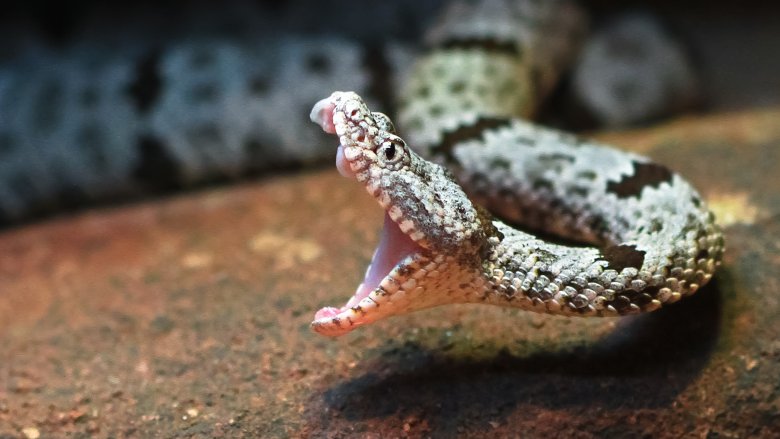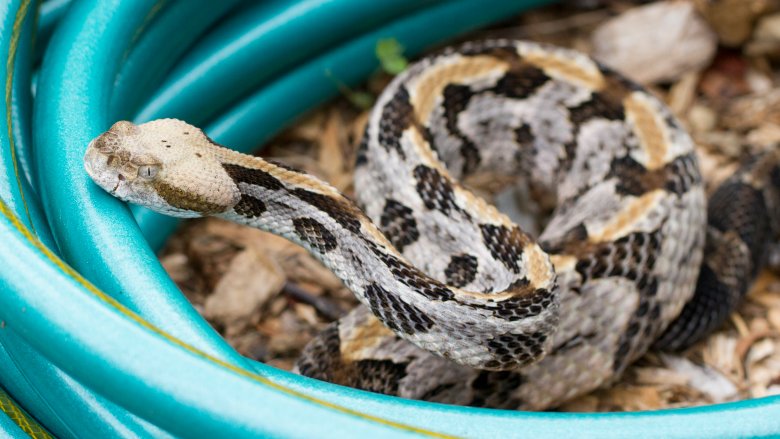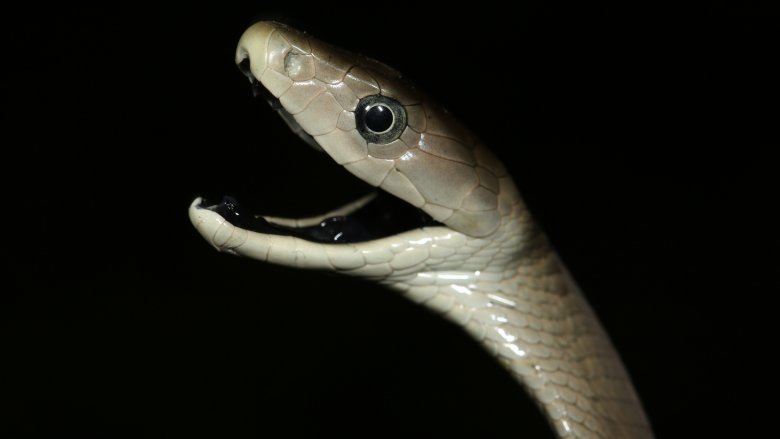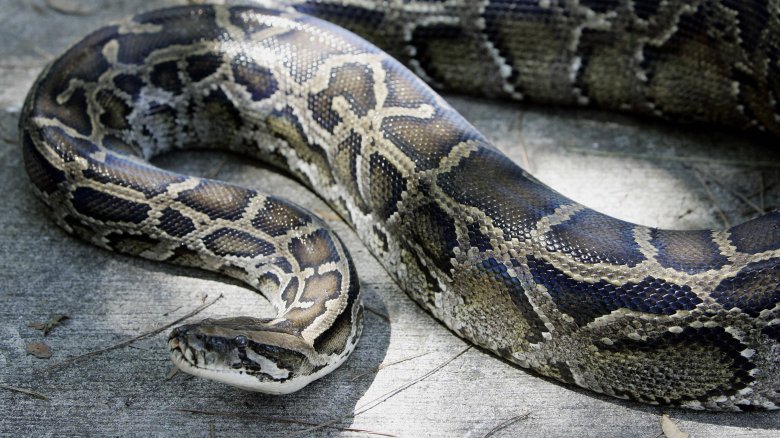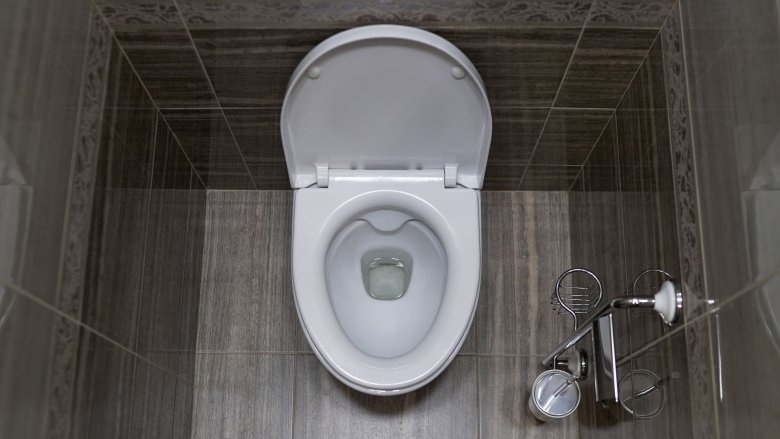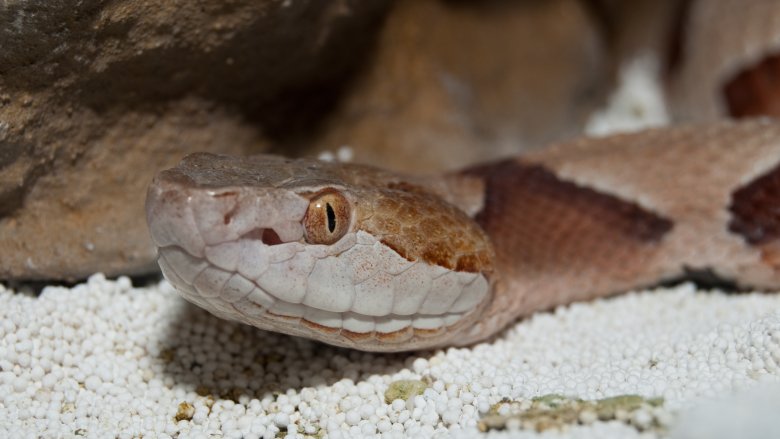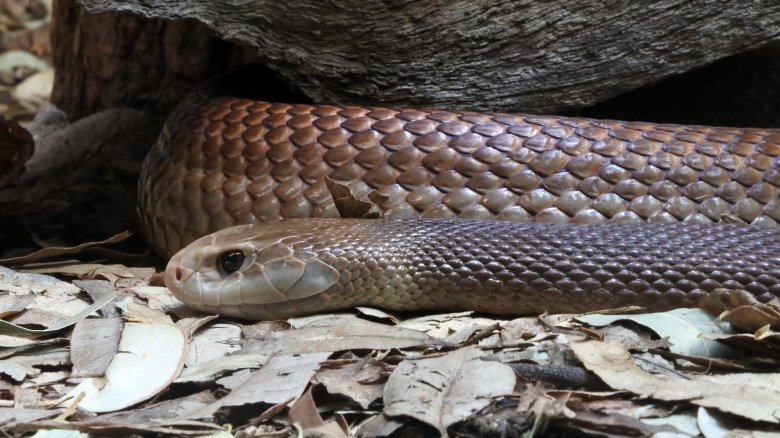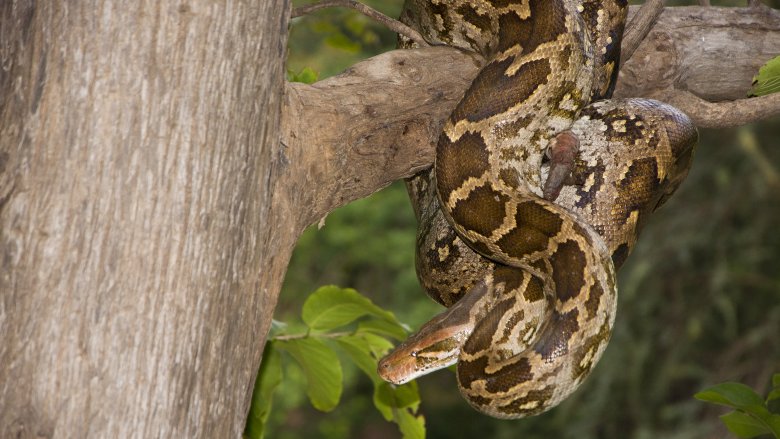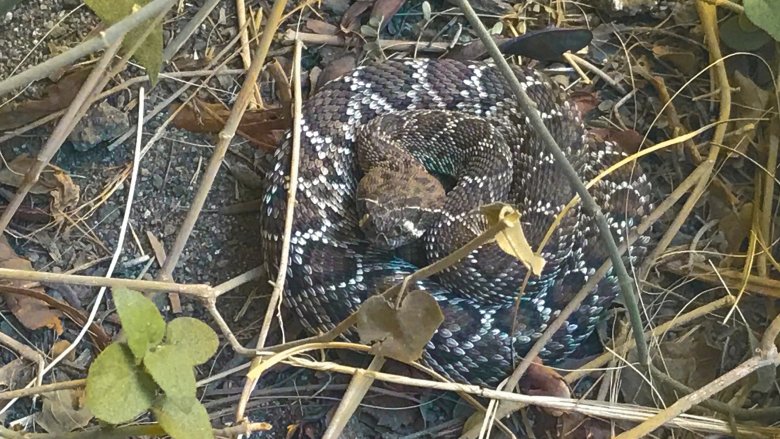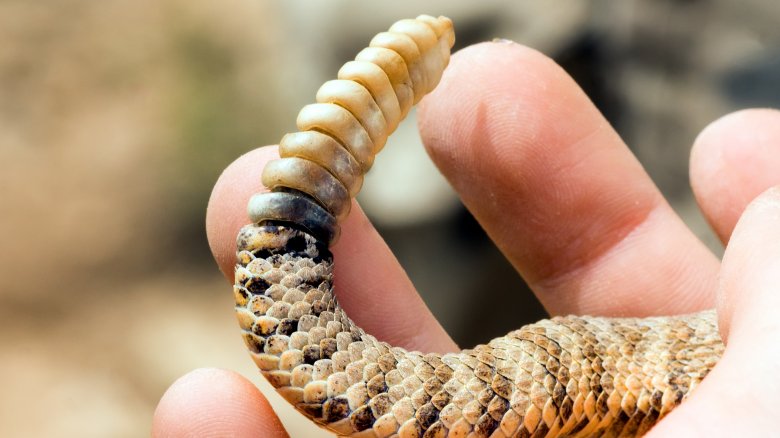Terrifying True Stories Of Encounters With Deadly Snakes
It's called ophidiophobia, and like its better-known cousin arachnophobia, it's actually served a useful purpose in the evolution of human beings. Fear of snakes kept our ancestors alive. In a world without doors, windows, or shovels, learning how to spot and avoid a deadly snake was a pretty important survival skill. That's why our fear of snakes is sometimes so irrational. If you're going to save yourself from a venomous attacker, it's a really good idea to run from every snake, rather than wasting precious time trying to decide which ones you actually need to be afraid of.
Today we know more than we used to. Most people can tell the difference between a deadly rattlesnake and a harmless kingsnake, and yet we're still almost as terrified of the kingsnake as we are of the snake that actually possesses deadly venom. But some run-ins are terrifying no matter what. Here are some truly freaky tales of snake encounters, mostly the potentially deadly variety.
And you thought headless chickens were scary
What should you do if you encounter a rattlesnake in your backyard? Well, you can keep your distance and hope it goes on to live a life of peace and harmony and it never bites your children. Or, you can decapitate it with a shovel.
According to CNN, that's what Milo Sutcliffe did, but then the head of the decapitated snake enacted some cold revenge and bit him on the hand when he tried to pick it up.
Now, getting bit by a headless snake is not the same as getting bit by a whole snake. A headless snake doesn't have all its faculties intact. So while a head that's still attached to its body may be able to regulate its venom delivery, a headless snake just lets loose with whatever it has because hey, why not. It's not like it's ever going to have another chance.
Sutcliffe needed 26 doses of anti-venom and spent five days in a medically induced coma. Just to put that into perspective, a more typical number of rattlesnake anti-venom doses is two to nine. So the lesson here is not, "Don't decapitate rattlesnakes" (though many people will tell you to just leave them alone). The lesson is "Don't pick up the head of a decapitated rattlesnake" because it is still capable of biting for literally hours after it's been separated from its body.
A lovely evening, a moonlit walk, and three black mambas
National Geographic says the black mamba is "widely considered the world's deadliest snake." Mambas can grow up to 14 feet in length, they can slither at 12.5 mph, and their venom can kill you in 20 minutes. So really, that means if you live in black mamba territory you should sleep in a cement room with no doors and windows and you should never ever leave unless you can wrap your entire body up in several layers of carbon fiber. That's not really practical, though, so most people just kind of live with the daily threat and hope they won't step on one while walking home from a party.
One evening in Kenya, Cheposait Adomo was walking home from a party when a 6.5 foot black mamba coiled around her ankles and bit her three times. So that was awful, but then two other black mambas were all, "Hey, we can't let that other black mamba have all the fun!" and quickly slithered toward her, but were taken out by a guy with a machete before they could join the ankle-biting party.
Adomo was given anti-venom and survived, but thousands of people in sub-Saharan Africa aren't that lucky. An estimated 30,000 people die there from snake bites every year, partly because they're too far from a hospital, and partly because anti-venom costs more than an entire year's salary.
Ten-foot Burmese pythons do not make great late night companions
So you're working the night shift at a zoo, and you walk by a 10-foot Burmese python in its enclosure. You look at it, and it looks at you. You think to yourself, "That snake looks like it wants to eat me." It thinks to itself, "I want to eat that guy." You get a chill down your spine and then you go admire the tree frogs. You do not then proceed to open up the python's cage.
But according to the BBC, that's what 29-year-old biology student Erick Arrieta did, though no one knows why. When employees arrived the next morning, they found the snake coiled around Arrieta's body, apparently in the process of trying to swallow his head. They beat the snake until it released him, but it was too late.
Now, you could blame just about anyone for this horrible incident. Arrieta should not have entered the python's cage, and he especially should not have entered the python's cage late at night while he was the only employee on the premises. On the other hand, you could also blame the 10-foot snake for doing exactly what you'd expect it to do. Still, the fact that Arrieta even entered the cage is bizarre — maybe The Jungle Book was onto something when it demonstrated that pythons have weird mind control powers.
Yes, snakes can actually come up toilets
So disclaimer: This is not technically an encounter with a "deadly" snake, but that doesn't make the story any less horrific. Compared to a black mamba, the bite of a python is not terrible. Pythons don't have venom, so a python bite hurts, and it scares the heck out of you, but it's not going to kill you. Now, knowing that, if you had the option to be bitten by a rattlesnake on the leg or by a python on your man parts, which one would you choose?
In this horrible story, a man in Thailand was using his toilet when a python literally came out of it and bit him on his baby-making unit. According to CNN, he lost so much blood that he had to be transferred to a local hospital.
And if that's not horrible enough, one of the rescue workers who responded to the scene said in a rather shockingly flippant way that snakes come out of toilets all the time in Thailand, but you know, it's usually not such a big deal because they "mostly would [bite] at legs or butts." Oh, well that's acceptable then!
Anyway, CNN said both man and snake survived, although the toilet had to be dismantled to get the snake out, and the man probably only ever peed in jars and Starbucks cups from that moment forward.
Most restaurants that serve rattlesnake make sure it's dead first
If you happen to live in a place where there are venomous snakes, you know you should look out for them while you're gardening, or when you're walking home from parties, or (evidently) when you're using the toilet. Never in a million years would you imagine that you have to check your booth for copperheads before you sit down for a meal at a restaurant, but after you read this that's what you're going to do probably every time, right after you check the restrooms for pythons.
According to CBS, Rachel Myrick was having a meal at a LongHorn Steakhouse in St. Fredericksburg, Virginia when she felt a stinging sensation in her foot. She thought it was a bee because no one thinks "Oh my god venomous snake" while they're sitting in a steakhouse, but as it turned out it was an 8-inch copperhead and it bit her three times.
Myrick was taken to a nearby hospital, where she received anti-venom. You have to assume it's hard for her to go back to a LongHorn Steakhouse without wearing heavy leather combat boots. It seems like the logical course of action. It's just too bad that you can't also wear heavy leather combat boots on your man parts.
What's that next to my juice box?
Rattlesnakes are scary, but compared to some of the world's other snakes they're kind of like Pomeranians to Rottweilers. Venomous Pomeranians that will go for your jugular even after you've decapitated them, but still.
Australia is way worse than rattlesnake country. Australia has taipans (the most venomous land snakes in the world), yellow-bellied sea snakes, mainland tiger snakes, beaked sea snakes, and Sydney funnel web spiders. Okay, that last one isn't a snake, but it's very terrifying. There are also eastern brown snakes, which are the world's second most venomous land snakes, so Australia gets to be home to the two most venomous land snakes in the world, which is so not awesome for people who live in Australia.
Snakes in Australia are so common that people can't get away with just checking under restaurant tables and making sure all's clear before using the toilet. According to Newsweek, an Australian mom was packing her child's lunch in 2018 when she found a hatchling eastern brown snake curled up inside it. Aww, but it's just a baby, right? Yes, it's a baby, but baby brown snakes are just as dangerous as adults, except smaller, which means they can pretty easily get into your lunchbox, your shoe, or the pair of pants you left lying on the bathroom floor.
Happily, no one got bitten by the lunchbox snake.
If you're going to harvest palm oil in the jungle, bring a friend with a really big machete
So just in case you thought that a python eating a human was an impressive yet futile attempt, here's a story about a python that managed the sickening feat. Hold onto your lunch.
According to CBS, a 25-year-old Indonesian man identified as Akbar went missing while out harvesting palm oil in March 2017. After searching for a little while, local villagers discovered a 23-foot reticulated python that was "bloated and moving awkwardly" near the spot where they also found Akbar's tools and one of his boots. They cut the snake open and found the missing man inside.
Evidently, this was the first case of a person being killed and eaten by a snake in the region, though that's really not super comforting. On the other hand, a 23-foot snake would probably not fit in your toilet, though so at least that's one less thing to worry about if you live in the area.
Even your kid's toys aren't safe
We love to think our children are safe in our own backyards, and that their lunchboxes only have apples and PB&J in them, but that would be sort of naive. The truth is snakes are planning to kill us all, we just haven't found their underground supervillain staging area yet.
According to Austin360, an Abilene, Texas, toddler was playing in his backyard when he started to cry. His mom saw blood on his hand and identified the marks as a snake bite. Then she saw the snake: It was a juvenile rattlesnake that had been hiding near the boy's toys and slide. Now you may have heard that baby snakes are more deadly than adults, but that's sort of a myth. While it is true that baby snakes are inexperienced and tend to let loose pretty much all their venom when they strike, their venom has been shown to be less potent and they don't have as much of it as the adults do, so bites from adults usually cause more damage. Still, the boy was only 1 year old, which means his weight-to-venom ratio wasn't very high. The bite required surgery and more than two dozen vials of anti-venom.
You really need to be told not to take selfies with rattlesnakes?
Most snakebite stories inspire empathy, but sometimes you hear a snakebite story and you think to yourself, "Eh ... that person kinda had it coming." Fortunately this particular person survived because we wouldn't wish snakebite death on anyone, but you don't have to be a herpetologist to know that taking a selfie with a rattlesnake is a really stupid idea.
According to the Huffington Post, in Lake Elsinore, California, in 2015 a 36-year-old man found a rattlesnake and then ... wait for it ... he put it around his neck so he could take a picture. Then he tried to rearrange it into a cooler pose so he could take a second selfie, and it bit him on the thumb. Because rattlesnakes don't do duck lips or Instagram, and they are venomous and they bite when they feel threatened. In case you didn't know that.
Rattlesnake selfies are evidently A Thing because in earlier that year another California man tried to take a selfie with a rattlesnake and ended up with a $153,000 hospital bill. More than $83,000 of that bill was just for the anti-venom because he needed pretty much all of it. From two hospitals.
The Lake Elsinore man was in danger of losing his thumb and possibly of never regaining the use of his hand. He learned his lesson, though. "Don't mess with snakes," he said from the hospital. "Leave them alone." Brilliant!
If venomous snakes haunt your dreams, don't read this
And finally, in case you think the only place left where you can really be safe from snakes is your own bed, in Silver Spring, Maryland, in 2017, 24-year-old Christie Kelly was awoken by a sudden, horrible pain in her hand. According to the Washington Post, she jumped up, turned on the light, and discovered there was an adult copperhead rattlesnake in her bed.
So before you start wondering if snakes now have teleportation powers or something, Kelly lived in the finished basement of a home that had recently undergone construction work, which might have given the snake a way in. And because snakes are cold-blooded animals, they gravitate toward things that are warm, like sleeping humans.
Kelly received four vials of anti-venom and had to undergo three surgeries or risk losing her hand. She told a reporter she was perfectly happy to be in the hospital, though. "At least there are no snakes here," she said. "Going back home, I don't see myself going back in the same room or the same bed."
Sweet dreams, everyone.
